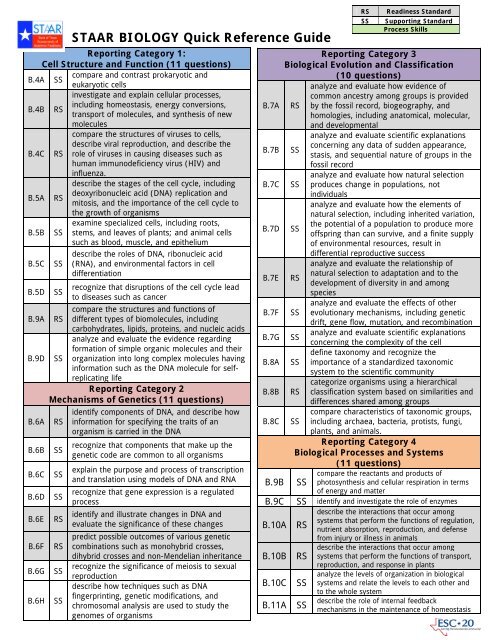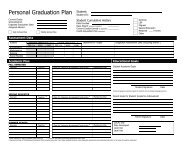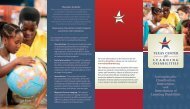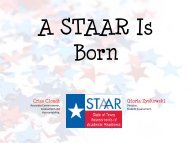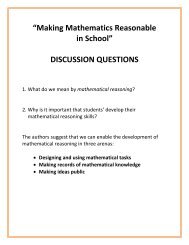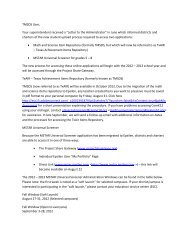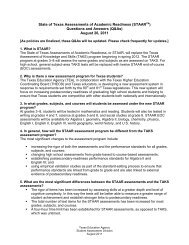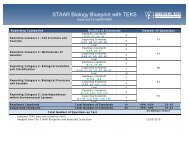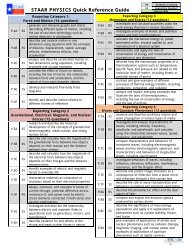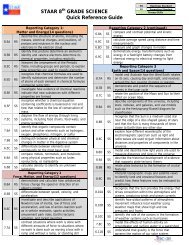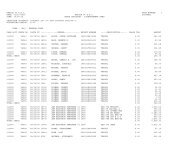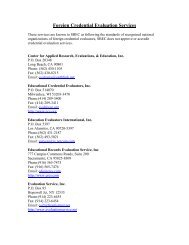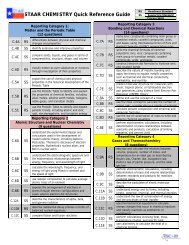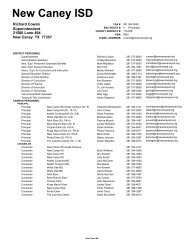STAAR BIOLOGY Quick Reference Guide
STAAR BIOLOGY Quick Reference Guide
STAAR BIOLOGY Quick Reference Guide
You also want an ePaper? Increase the reach of your titles
YUMPU automatically turns print PDFs into web optimized ePapers that Google loves.
<strong>STAAR</strong> <strong>BIOLOGY</strong> <strong>Quick</strong> <strong>Reference</strong> <strong>Guide</strong><br />
Reporting Category 1:<br />
Cell Structure and Function (11 questions)<br />
B.4A SS<br />
compare and contrast prokaryotic and<br />
eukaryotic cells<br />
investigate and explain cellular processes,<br />
B.4B RS<br />
including homeostasis, energy conversions,<br />
transport of molecules, and synthesis of new<br />
molecules<br />
compare the structures of viruses to cells,<br />
describe viral reproduction, and describe the<br />
B.4C RS role of viruses in causing diseases such as<br />
human immunodeficiency virus (HIV) and<br />
influenza.<br />
describe the stages of the cell cycle, including<br />
B.5A RS<br />
deoxyribonucleic acid (DNA) replication and<br />
mitosis, and the importance of the cell cycle to<br />
the growth of organisms<br />
examine specialized cells, including roots,<br />
B.5B SS stems, and leaves of plants; and animal cells<br />
such as blood, muscle, and epithelium<br />
describe the roles of DNA, ribonucleic acid<br />
B.5C SS (RNA), and environmental factors in cell<br />
differentiation<br />
B.5D SS<br />
recognize that disruptions of the cell cycle lead<br />
to diseases such as cancer<br />
B.9A RS<br />
compare the structures and functions of<br />
different types of biomolecules, including<br />
carbohydrates, lipids, proteins, and nucleic acids<br />
analyze and evaluate the evidence regarding<br />
formation of simple organic molecules and their<br />
B.9D SS organization into long complex molecules having<br />
information such as the DNA molecule for selfreplicating<br />
life<br />
Reporting Category 2<br />
Mechanisms of Genetics (11 questions)<br />
B.6A RS<br />
B.6B SS<br />
B.6C SS<br />
B.6D SS<br />
B.6E RS<br />
B.6F RS<br />
B.6G SS<br />
B.6H SS<br />
identify components of DNA, and describe how<br />
information for specifying the traits of an<br />
organism is carried in the DNA<br />
recognize that components that make up the<br />
genetic code are common to all organisms<br />
explain the purpose and process of transcription<br />
and translation using models of DNA and RNA<br />
recognize that gene expression is a regulated<br />
process<br />
identify and illustrate changes in DNA and<br />
evaluate the significance of these changes<br />
predict possible outcomes of various genetic<br />
combinations such as monohybrid crosses,<br />
dihybrid crosses and non-Mendelian inheritance<br />
recognize the significance of meiosis to sexual<br />
reproduction<br />
describe how techniques such as DNA<br />
fingerprinting, genetic modifications, and<br />
chromosomal analysis are used to study the<br />
genomes of organisms<br />
RS Readiness Standard<br />
SS Supporting Standard<br />
Process Skills<br />
Reporting Category 3<br />
Biological Evolution and Classification<br />
(10 questions)<br />
analyze and evaluate how evidence of<br />
common ancestry among groups is provided<br />
B.7A RS by the fossil record, biogeography, and<br />
homologies, including anatomical, molecular,<br />
and developmental<br />
analyze and evaluate scientific explanations<br />
B.7B SS<br />
concerning any data of sudden appearance,<br />
stasis, and sequential nature of groups in the<br />
fossil record<br />
analyze and evaluate how natural selection<br />
B.7C SS produces change in populations, not<br />
individuals<br />
analyze and evaluate how the elements of<br />
natural selection, including inherited variation,<br />
B.7D SS<br />
the potential of a population to produce more<br />
offspring than can survive, and a finite supply<br />
of environmental resources, result in<br />
differential reproductive success<br />
analyze and evaluate the relationship of<br />
B.7E RS<br />
natural selection to adaptation and to the<br />
development of diversity in and among<br />
species<br />
analyze and evaluate the effects of other<br />
B.7F SS evolutionary mechanisms, including genetic<br />
drift, gene flow, mutation, and recombination<br />
B.7G SS<br />
analyze and evaluate scientific explanations<br />
concerning the complexity of the cell<br />
define taxonomy and recognize the<br />
B.8A SS importance of a standardized taxonomic<br />
system to the scientific community<br />
categorize organisms using a hierarchical<br />
B.8B RS classification system based on similarities and<br />
differences shared among groups<br />
compare characteristics of taxonomic groups,<br />
B.8C SS including archaea, bacteria, protists, fungi,<br />
plants, and animals.<br />
Reporting Category 4<br />
Biological Processes and Systems<br />
(11 questions)<br />
B.9B SS<br />
compare the reactants and products of<br />
photosynthesis and cellular respiration in terms<br />
of energy and matter<br />
B.9C SS identify and investigate the role of enzymes<br />
B.10A RS<br />
B.10B RS<br />
B.10C SS<br />
B.11A SS<br />
describe the interactions that occur among<br />
systems that perform the functions of regulation,<br />
nutrient absorption, reproduction, and defense<br />
from injury or illness in animals<br />
describe the interactions that occur among<br />
systems that perform the functions of transport,<br />
reproduction, and response in plants<br />
analyze the levels of organization in biological<br />
systems and relate the levels to each other and<br />
to the whole system<br />
describe the role of internal feedback<br />
mechanisms in the maintenance of homeostasis
Reporting Category 5<br />
Interdependence within Environmental<br />
Systems (11 questions)<br />
investigate and analyze how organisms,<br />
B.11B SS populations, and communities respond<br />
to external factors<br />
summarize the role of microorganisms in<br />
B.11C SS<br />
both maintaining and disrupting the<br />
health of both organisms and<br />
ecosystems<br />
describe how events and processes that<br />
B.11D RS occur during ecological succession can<br />
change populations and species diversity<br />
interpret relationships, including<br />
B.12A RS<br />
predation, parasitism, commensalism,<br />
mutualism, and competition among<br />
organisms<br />
B.12B SS<br />
compare variations and adaptations of<br />
organisms in different ecosystems<br />
analyze the flow of matter and energy<br />
B.12C RS<br />
through trophic levels using various<br />
models, including food chains, food<br />
webs, and ecological pyramids<br />
recognize that long-term survival of<br />
B.12D SS species is dependent on changing<br />
resource bases that are limited<br />
describe the flow of matter through the<br />
B.12E SS<br />
carbon and nitrogen cycles and explain<br />
the consequences of disrupting these<br />
cycles<br />
B.12F RS<br />
describe how environmental change can<br />
impact ecosystem stability<br />
Readiness<br />
Standards<br />
Supporting<br />
Standards<br />
Number of<br />
Standards<br />
Number of Questions<br />
16 60 – 65% 32 – 35<br />
26 35 – 40% 19 – 22<br />
54 Multiple Choice Questions<br />
B.1A<br />
B.1B<br />
B.2A<br />
B.2B<br />
B.2C<br />
B.2D<br />
B.2E<br />
B.2F<br />
B.2G<br />
B.2H<br />
B.3A<br />
B.3B<br />
B.3C<br />
B.3D<br />
B.3E<br />
B.3F<br />
Process Skills<br />
Embedded in at least 40% of the questions<br />
demonstrate safe practices during laboratory and field<br />
investigations<br />
demonstrate an understanding of the use and<br />
conservation of resources and the proper disposal or<br />
recycling of materials<br />
know the definition of science and understand that it has<br />
limitations, as specified in subsection (b)(2) of this section<br />
know that hypotheses are tentative and testable<br />
statements that must be capable of being supported or<br />
not supported by observational evidence. Hypotheses of<br />
durable explanatory power which have been tested over a<br />
wide variety of conditions are incorporated into theories<br />
know scientific theories are based on natural and physical<br />
phenomena and are capable of being tested by multiple<br />
independent researchers. Unlike hypotheses, scientific<br />
theories are well-established and highly-reliable<br />
explanations, but they may be subject to change as new<br />
areas of science and new technologies are developed<br />
distinguish between scientific hypotheses and scientific<br />
theories<br />
plan and implement descriptive, comparative, and<br />
experimental investigations, including asking questions,<br />
formulating testable hypotheses, and selecting equipment<br />
and technology<br />
collect and organize qualitative and quantitative data and<br />
make measurements with accuracy and precision using<br />
tools such as calculators, spreadsheet software, datacollecting<br />
probes, computers, standard laboratory<br />
glassware, microscopes, various prepared slides,<br />
stereoscopes, metric rulers, electronic balances, gel<br />
electrophoresis apparatuses, micropipettors, hand lenses,<br />
Celsius thermometers, hot plates, lab notebooks or<br />
journals, timing devices, cameras, Petri dishes, lab<br />
incubators, dissection equipment, meter sticks, and<br />
models, diagrams, or samples of biological specimens or<br />
structures<br />
analyze, evaluate, make inferences, and predict trends<br />
from data<br />
communicate valid conclusions supported by the data<br />
through methods such as lab reports, labeled drawings,<br />
graphic organizers, journals, summaries, oral reports, and<br />
technology-based reports<br />
in all fields of science, analyze, evaluate, and critique<br />
scientific explanations by using empirical evidence, logical<br />
reasoning, and experimental and observational testing,<br />
including examining all sides of scientific evidence of<br />
those scientific explanations, so as to encourage critical<br />
thinking by the student<br />
communicate and apply scientific information extracted<br />
from various sources such as current events, news<br />
reports, published journal articles, and marketing<br />
materials<br />
draw inferences based on data related to promotional<br />
materials for products and services<br />
evaluate the impact of scientific research on society and<br />
the environment<br />
evaluate models according to their limitations in<br />
representing biological objects or events<br />
research and describe the history of biology and<br />
contributions of scientists


